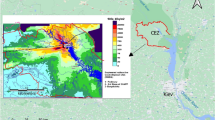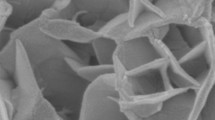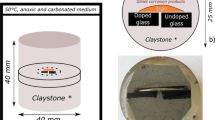Abstract
DISSOLUTION and transport of radionuclides by ground-water are the main threats to the effective isolation of radioactive wastes by burial in deep geological formations. Calcine and glass are two solid forms which have been studied in this way for radioactive waste disposal. Long term release rates, based on extractions of radionuclides by simulated groundwater at 25 °C and atmospheric pressure, are projected to be very low from borosilicate glass, the most favourable candidate waste form. We present here evidence that contact with pressurised water at the 200–400 °C temperatures that could occur near the waste in the early years of storage rapidly alters the borosilicate glass and promotes interactions between waste and both shale and basalt repository wall rocks. The specific examples are the formation of a uranyl silicate (weeksite) directly from hydrothermal alteration of the glass and the reaction of caesium and sodium from calcine with aluminosilicates in basalt and shale to form the caesium sodium aluminosilicate, pollucite.
This is a preview of subscription content, access via your institution
Access options
Subscribe to this journal
Receive 51 print issues and online access
$199.00 per year
only $3.90 per issue
Buy this article
- Purchase on Springer Link
- Instant access to full article PDF
Prices may be subject to local taxes which are calculated during checkout
Similar content being viewed by others
References
Cohen, B. L. Rev. mod. Phys. 49, 1–19 (1977); Scient. Am. 236, 21–31 (1977).
de Marsily, G., Ledoux, E., Barbreau, A. & Margat, J. Science 197, 519–527 (1977).
Culler, F., Jr. (ed.)Proc. Int. Symp. Management of Waste from the LWR Fuel Cycle (US Energy Research and Development Administration, CONF-76-0701, 1976).
McCarthy, G. J. Nucl. Technol. 32, 92–105 (1977).
Dé, A. K., Luckscheiter, B., Lutze, W., Malow, G. & Schiewer, E. Am. ceram. Soc. Bull. 55, 500–503 (1976).
Hespe, E. D. Atomic Energy Rev. 9, 1–9 (1971).
Mendel, J. E. (ed.) A. Rep. Characteristics of High-Level Waste Glasses (US Energy Research and Development Administration Report BNWL-2252, Battelle Pacific Northwest Laboratories, 1977).
Jenks, G. H. in NWTS Conf. on Waste-Rock Interactions (US Energy Research and Development Administration Report Y/OWI/SUB-77/14268, 5016, 1977).
Roy, R. & Tuttle, O. F. in Physics and Chemistry of the Earth 1, 138–180 (Pergamon, London, 1956).
Roy, R. J. Am. ceram. Soc. 39, 145–146 (1956).
Hawkins, D. B. & Roy, R. Geochim. cosmochim. Acta 27, 1047–1054 (1963).
McElroy, J. L. (ed.) Research and Development Activities, Waste Fixation Program (US Energy Research and Development Administration, BNWL-1908, Battelle Pacific Northwest Laboratories, 1975).
Komarneni, S., McCarthy, G. J. & Gallagher, S. A. Inorg. nucl. chem. Lett. (in the press).
Author information
Authors and Affiliations
Rights and permissions
About this article
Cite this article
MCCARTHY, G., WHITE, W., ROY, R. et al. Interactions between nuclear waste and surrounding rock. Nature 273, 216–217 (1978). https://doi.org/10.1038/273216a0
Received:
Accepted:
Issue Date:
DOI: https://doi.org/10.1038/273216a0
This article is cited by
-
A comparative study on pyrochlore phase formation in La2Zr2O7 in microscopic and macroscopic scale
Journal of Radioanalytical and Nuclear Chemistry (2024)
-
Combustion synthesis of oxide materials for nuclear waste immobilization
Bulletin of Materials Science (1994)
-
Monazite-like phases containing transuranium elements (neptunium and plutonium)
Journal of Materials Science Letters (1988)
-
Pressure dependence of glass dissolution and nuclear waste disposal
Nature (1982)
-
Hydrothermal leaching of rhyolite glass in the environment has implications for nuclear waste disposal
Nature (1981)
Comments
By submitting a comment you agree to abide by our Terms and Community Guidelines. If you find something abusive or that does not comply with our terms or guidelines please flag it as inappropriate.



